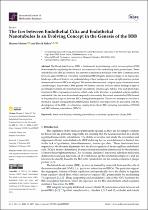| dc.contributor.author | Mentor, Shireen | |
| dc.contributor.author | Fisher, David | |
| dc.date.accessioned | 2022-09-19T09:49:29Z | |
| dc.date.available | 2022-09-19T09:49:29Z | |
| dc.date.issued | 2022 | |
| dc.identifier.citation | Mentor, S., & Fisher, D. (2022). The Ism between endothelial cilia and endothelial nanotubules is an evolving concept in the genesis of the BBB. International Journal of Molecular Sciences, 23(5), 2457. https://doi.org/10.3390/ijms23052457 | en_US |
| dc.identifier.issn | 1422-0067 | |
| dc.identifier.uri | https://doi.org/10.3390/ijms23052457 | |
| dc.identifier.uri | http://hdl.handle.net/10566/7912 | |
| dc.description.abstract | The blood–brain barrier (BBB) is fundamental in maintaining central nervous system (CNS)
homeostasis by regulating the chemical environment of the underlying brain parenchyma. Brain
endothelial cells (BECs) constitute the anatomical and functional basis of the BBB. Communication
between adjacent BECs is critical for establishing BBB integrity, and knowledge of its nanoscopic
landscape will contribute to our understanding of how juxtaposed zones of tight-junction protein
interactions between BECs are aligned. The review discusses and critiques types of nanostructures
contributing to the process of BBB genesis. We further critically evaluate earlier findings in light of
novel high-resolution electron microscopy descriptions of nanoscopic tubules. | en_US |
| dc.language.iso | en | en_US |
| dc.publisher | MDPI | en_US |
| dc.subject | Brain endothelium | en_US |
| dc.subject | Nanotubules | en_US |
| dc.subject | Central nervous system | en_US |
| dc.subject | Bioscience | en_US |
| dc.title | The Ism between endothelial cilia and endothelial nanotubules is an evolving concept in the genesis of the BBB | en_US |
| dc.type | Article | en_US |

